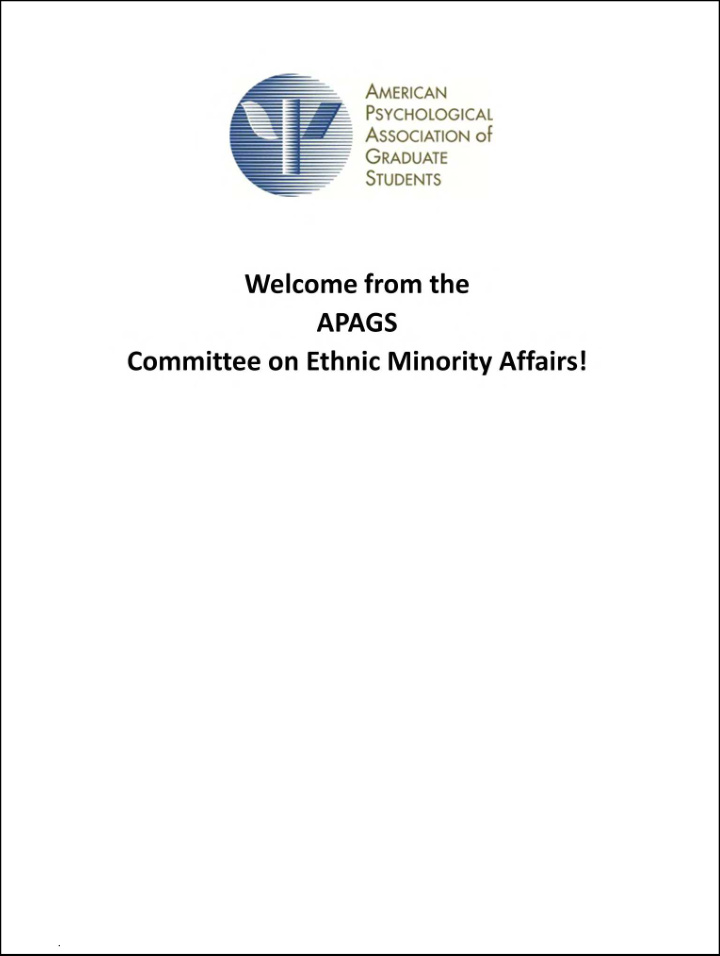



.
.
Special thanks to my colleagues on the APA Presidential Immigration Task Force for their contribution of slides Michael Zaráte, Ph.D. Dina Birman, Ph.D. Usha Tummala-Narra. Ph.D. J. Manuel Casas, Ph.D. Nadine Nakamura, Ph.D 3 .
NEARLY THREE QUARTERS OF IMMIGRANT POPULATION ARE EITHER NATURALIZED OR AUTHORIZED NON- CITIZENS EWI’s (60%) Largely Latino Overstayers (40%) UN — extremely diverse 4 .
With the exception of our northern neighbor Canada, by 2009, 9 of the top 10 leading countries of origin, are in Asia, Latin America, or the Caribbean. DIVERSITY — Racially and Ethnically LINGUISTICALLY --460 languages are spoken at home (Kindler, 2002) 62% speak Spanish; 19% speak another Indo-European language; 15% speak an Asian and Pacific Island language, and the remaining 4% speak another language (Shin & Komiski, 2010). RELIGIOUSLY — Catholic; Evangelic; as a result of new immigrant populations, from 1970 to 2000, the non-Judeo Christian religions in the United States (Hinduism, Islam, Sikhism) grew from 0.8% to 2.6% combined (Eck, 2001; Pew Forum on Religious Life, 2008). 5 .
Immigrant adults and children arrive in the United States with varied levels of education. At one end of the spectrum are highly educated immigrant adults (Portes & Rumbaut, 2006) ¼ of all U.S. physicians, 24% of science and engineering workers with BAs, and 47% scientists with doctorates; it is likely that as the 2010 Census data are released these percentages will be higher (Kerr & Lincoln, 2010). 6 .
After nearly every war, we can trace a subsequent movement of people (Zolbberg, 1989). For example, following the ending of the Spanish American war in 1898, migration began out of Philippines and Puerto Rico to the U.S.; likewise migration flows began out of Korean after the Korean War ended in 1953 and out of Vietnam, Laos, and Cambodia when the Vietnamese war ended in 1975. Today, current conflicts in Iraq and Afghanistan are resulting in large-scale displacement and substantial flows to the U.S. (U.N. High Commission on Refugees, 2010). 7 .
• WU Template v7 1.4.08 Approximately 25 million people are now “environmental refugees.” Environmental migration is a fairly new domain to be recognized in scholarship and thus there is limited data available; yet according to some estimates, environmental degradation, especially deforestation and rising sea levels, is projected to cause 200 million people to become refugees by 2050 (UNEP, 2010). 8 .
ABOVE ALL – Family and family re-unification is what motivates most migrations. An estimated 2/3rds of migrations are motivated by family reunifications 9 .
~ Today, nearly One in Four (23%) of Children in the U.S. is the Child of an Immigrant ~Fastest Growing Sector of U.S. Child Population ~In 1970 just (6%) and they are projected to account for One in Three children by 2020 ~ These over 16 million kids are arriving not to just the usual receiving centers like NYC, LA, Chicago, & Miami, but also to the heartland and suburbs not used to serving these kids ~ 86% are citizen children 10 .
11 .
12 .
END WITH A REMINDER: While the absolute number of immigrant adults and children in the United States is at an all-time high, the rate of immigration today is actually lower than during the last era of mass migration when Europeans began a massive exodus from the Old World. In 1910, the rate of immigration reached a peak of 14.7%; in comparison in 2009 we were at a rate of 12.5%. As a nation, we have managed large proportions of immigrants in the past. At the time, there were similar concerns about who these newcomers were and whether the nation should and could absorb them. Then the worries were whether a predominantly Protestant nation could absorb the Catholic and Jewish immigrants (Stop for a moment and consider that ALL of the Supreme Court Judges today are either Jewish or Catholic…) Clearly, we are a stronger and more interesting nation for having gone through this process. 13 .
Context matters 14 .
15 .
16 .
17 .
18 .
.
20 .
The Namesake .
.
.
.
.
.
.
.
.
Real Women Have Curves .
.
.
.
.
.
.
.
.
.
.
41 .
All too much of our current research is done through a middle class American framework. Does not separate out immigrant generation or country or immigrant origin. Lumps together all Latinos or Asians as if thy were a monolith Lot of gaps in our knowledge 42 .
.
.
All too much of our current research is done through a middle class American framework. Does not separate out immigrant generation or country or immigrant origin. Lumps together all Latinos or Asians as if thy were a monolith Lot of gaps in our knowledge 45 .
.
.
Recommend
More recommend